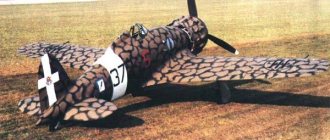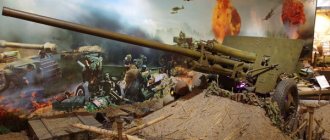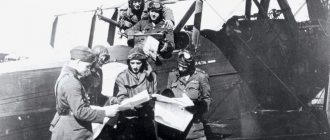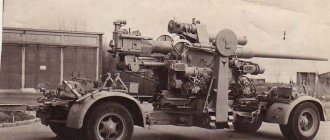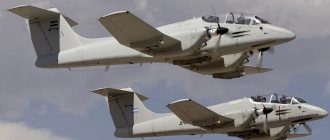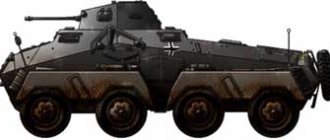"Chance-Vout F4U Corsair"
The history of the creation of the Corsair carrier-based fighter dates back to 1938. Then the US Navy decided to replace its outdated fighters with new generation machines. Several aviation companies then came up with designs for their aircraft. Among them was Chance Vought. The chief designer of the company, engineer Rex Beisel, unlike his competitors, relied on the XR-2800 engine, the most powerful for that time. And although this promising engine was still “raw” and required fine-tuning, Beisel’s project (V-166B) made a good impression on customers, and in July 1938 a contract was signed for the construction of a prototype aircraft, designated XF4U-1.
A year and a half later, the project for a new fighter was embodied in metal. It was an all-metal monoplane with consoles partially covered with canvas. The characteristic shape was given by the wing, made in the “reverse gull” type. It was articulated at right angles with the fuselage of circular cross-section. This reduced the aerodynamic interference between it and the fuselage and did not require the installation of complex-shaped fairings, which was typical for other vehicles. Thanks to the W-shape of the wing, the landing gear turned out to be relatively small and were compactly retracted into it.
The XR-2800-4 engine was immediately installed on the aircraft, the power of which at takeoff was 1800 hp, at a combat altitude of 7 km - 1460 hp. The XF4U-1 is armed with two synchronized fuselage machine guns of 7.62 mm caliber and two wing-mounted 12.7 mm caliber machine guns. It was assumed that the aircraft should also carry 20 special 2.35-kilogram bombs to destroy enemy bombers in the air.
On May 29, 1940, test pilot Lyman Bullard flew the aircraft for the first time. Flight tests of the new aircraft exceeded all expectations. Within a few days, the XF4U-1 reached a flight speed of 651.7 km/h and became the fastest American military aircraft of that period.
In October 1940, the aircraft was transferred to the Navy for testing. On March 3, 1941, a contract for its serial production was signed. True, the military demanded that the armament be increased to six wing-mounted heavy machine guns with a total ammunition of 2,350 rounds. This was done. The location of the pilot's cabin has been slightly changed. The aircraft received an improved R-2800-8 engine, the power of which was increased to 2000 hp. In this form, the vehicle, designated F4U-1, went into production. On June 25, 1942, the first one (serial number 02153) took off, and a week later they began equipping the Sangamon aircraft carrier with new aircraft.
But the Americans still missed time. On December 7, 1941, the Japanese, having defeated the US naval base in Pearl Harbor, began active military operations in the Pacific Ocean. US Wildcat fighters had a rather difficult time in battles with the new Japanese Zeros.
The delay in deliveries of the Corsairs, which the fleet had been waiting for so long, made it possible to launch the F6F Hellcat, which became the main carrier-based fighter of the American fleet. The Hellcats shot down more than five thousand Japanese aircraft (75% of all naval air victories), but this did not change the military’s attitude towards the Corsair. And although the Corsairs were needed in the theater of operations like air, the command of the American Navy still did not dare to throw into battle pilots who had not yet properly mastered the new machine. Only at the beginning of 1943 did the first squadron of F4U-1s arrive in the area of the island. Guadalcanal.
The Navy command expected to use the new Corsairs primarily as carrier-based fighter-interceptors. But unsuccessful attempts to use the F4U-1 from aircraft carriers forced the US military to use fighters for the first time in ground units of the Marine Corps. The first unit to receive the Corsairs was the VMF-124 squadron, organized on September 7, 1942 at the Camp Kerne base in California. The unit underwent training on a new vehicle and on December 28, 1942 it was recognized as combat ready. The squadron was armed with 22 F4U-1 fighters.
On February 12, 1943, VMF-124 was transferred to the island of Guadalcanal in the Solomon Islands archipelago. On the same day, the new fighters carried out their first combat mission to escort PB4Y bombers that were raiding Japanese fleet ships in Buangville. But on this day they did not have the opportunity to come into combat contact with Japanese aircraft. While performing a similar mission on February 14, aircraft from VMF-124, along with P-40s and P-38s, were intercepted by fifty Japanese A6M Zero fighters. The debut for the F4U-1 Corsairs was unsuccessful; the squadron lost two aircraft in this battle. Total American losses were: four P-38s, two each F-4U, P-40 and PB4Y Liberator, with three Japanese fighters shot down.
Over the next two months, F4U-1 pilots developed special tactics that became standard in battles with the Japanese. Using the existing advantage of the Corsairs in speed characteristics, American pilots were the first to attack the Japanese. Noticing enemy aircraft, American pilots quickly gained altitude and dived at the enemy, destroying Japanese aircraft with machine-gun fire. After the attack, they exited the battle with a climb, occupying a new line for the next attack. Noticeably inferior to the Japanese Zeros in maneuverability, the F4U tried not to be drawn into close maneuver combat. In critical situations, the Corsair tried to break away from the pursuing enemy by quickly climbing or diving. Word of the new F4U-1's great capabilities spread as VMF-124 increased its victory count and more Marine aviation units began converting to the Corsairs.
Many pilots became aces while flying the F4U. Preparations for the use of the fighter on aircraft carriers were much more difficult. The first test takeoffs and landings, which took place on the aircraft carrier Sangamon in September-October 1942, revealed many shortcomings in the Corsair's design. So, sometimes the fighter suddenly, for no apparent reason, lost speed, fell onto the right wing and went into a tailspin. The high torque of the propeller during take-off and landing caused the aircraft to become unstable. The car was literally shaking left and right. The usual technique of landing on the deck of an aircraft carrier was virtually impossible. The engine limited the pilot's visibility, and drops of oil splashing from the engine onto the windshield of the canopy further impaired visibility. When landing, the pilot was forced to approach the aircraft carrier not in a straight line, but on a bend, in order to be able to see the deck. Immediately at the moment of landing, the plane lowered its nose and hit the deck extremely hard with its main wheels. The fighter often bounced on the hard shock absorbers of the landing gear and “bounced,” which often led to damage to the aircraft.
In this situation, the Navy leadership could not use the Corsairs as carrier-based fighters. Until the advent of the F4U-1D modification, every takeoff and landing on an aircraft carrier was associated with great risk. To confidently pilot the Corsair, the pilot needed to undergo serious, many hours of flight training. The number of F4U fighters lost for non-combat reasons far exceeded combat losses (349 aircraft were shot down by anti-aircraft artillery, 232 for other combat reasons, 690 during non-combat missions and 164 were destroyed during takeoffs and landings on aircraft carriers).
Since January 1943, the Sikorsky company joined the work on improving the aircraft, teaming up for a time with Chance Vought. Goodyear began production of the F4U-1 in February, and Brewster began production in April. The aircraft of these companies were designated FG-1 and F3A-1, respectively. At the same time, Chance Vaught began a large program to create a night carrier-based interceptor, the F4U-2, equipped with radar, and a high-altitude fighter, the F4U-3, with an R-2800-16C engine and a turbocharger that maintained a power of 2000 hp. With. up to an altitude of 12 km.
Taking into account the operating experience of the Corsairs, they developed the F4U-1A version with a new cockpit canopy, which replaced the U-1 modification on the conveyors of the companies Vought, Brewster and Goodyear.
Gradually, the Corsairs began to be used more and more widely in combat. Their good performance characteristics gave them superiority over enemy fighters. And even the famous Hellcats, which had better maneuverability, were inferior to them in speed. Indeed, at sea level the speed of the F4U-1A was 548 km/h, and at an altitude of 7 km - 636 km/h. For the F4U-3 (also produced in 1943), these figures were 521 and 605 km/h, respectively.
The ratio of victories in air battles with the Japanese was clearly on the side of the Corsairs. According to statistics, every 30 sorties the Corsair pilots shot down an enemy plane. Among the pilots who fought on the Corsairs were their own aces. For example, Major Boyngton scored 28 aerial victories. Captain Foss accounted for 26 downed aircraft.
The allies also fought on the Corsairs. More than two thousand vehicles were transferred to Great Britain under Lend-Lease (95 - F4U-1, 510 - F4U-1A, 430 - FZ-A and 977 FG-1). There they received the designation "Corsair" I, II, III and IV, respectively. 424 aircraft were in service with the New Zealand Air Force.
During serial production, the Corsair continued to improve. At the end of August 1943, the F4U-1C fighter rolled off the production lines, the armament of which consisted of four 20-mm cannons with 120 rounds of ammunition. In November, the US Navy began to receive the F4U-1D fighter-bomber, capable of carrying bombs weighing up to 908 kg or missiles with a caliber of up to 127 mm (8 pcs.). These aircraft were also equipped with new R-2800-8W engines with water-methanol boosting. This made it possible to briefly increase engine power to 2250 hp. The rate of climb increased from 14.5 m/s to 15.8 m/s (almost the same as the F6F-3). The maximum speed at an altitude of 6500 m is up to 670-680 km/h.
Since April 1944, Brewster and Goodyear also switched to the production of these aircraft (A3A-1D and FG1-D aircraft). In total, American factories produced 8.5 thousand F4U-1 of all types, of which Chance Vought accounted for 4102 airplane. 3808 cars were produced by Goodyear and 735 by Brevster. In 1944, instead of the F4U-1, fighters of the U-4 modification began to leave the factory workshops. In fact, it was the same “Corsair”, but equipped with a more powerful 2450-horsepower R-2800-18W engine and a new four-blade propeller.
Thanks to the improved power plant, the vehicle's combat capabilities have increased dramatically. The maximum speed increased to 683.km/h. The rate of climb reached 19.6 m/s and was even greater than that of the latest version of the Hellcat P6P-5, also released in 1944. For example, if the Hellcat gained a height of 954 m in one minute, then the Corsair - 1190 m. At the same time, the F4U-4 flew 50-60 km/h faster. Now, over the sea, the Corsair had no equal. The US Navy ordered six thousand aircraft at once. True, only about two thousand were built before the end of the war. Nevertheless, the F4U-4 managed to fight. These high-speed fighters, with their long flight range (which was greatly facilitated by the presence of two additional outboard fuel tanks), played a special role in battles with Japanese kamikazes, destroying them at distant approaches to their ships. The Corsairs also operated successfully against ground targets - especially the F4U-4B, armed with 20-mm cannons, bombs and missiles.
During the battles for the Japanese islands, the Corsairs received the nickname “Angels of Okinawa” from the American Marines.
After the end of the war, serial production of the F4U-4 gradually began to wind down and completely ceased in 1947 (2,356 vehicles were built). At the same time, some of the aircraft were produced as night interceptors, equipped with airborne radars installed in fairings on the right wing. They were designated F4U-4E and F4U-4M.
But the story of the “Corsairs” did not end there. The Goodyear company independently continued work on the creation of the Super Corsair. The F2G-1 and F2G-2 aircraft appeared with R-4360 Wasp Major engines producing 3,650 hp. With. In combat mode, they had a speed of 724 km/h and a climb rate of 22.35 m/s (418 F2G-1 and 10 F2G-2 were built).
Chance Vought from 1946 to 1951 produced another 568 vehicles of the F4U-5 modification, of which 315 were of the 5N and 5NL series with on-board radar. The F4U-5's maximum flight speed reached 724 km/h, although some pilots claimed to have flown much higher speeds.
In 1950, F4U-4 and U-5 fighters were sent to Korea. There, 82% of all strikes inflicted by carrier-based aircraft on the enemy were their share. True, in Korea they, as a rule, had to act on ground targets, since they could no longer fight the MiG-15 jets.
Taking into account the fighting in Korea, in 1952 the production of an improved attack aircraft was launched, which received the new designation AU-1 (F4U-6) in the fleet aviation. The aircraft was armed with four 20 mm cannons and could carry 10 missiles or six 227 kg bombs (110 aircraft were built).
In the same 1952, the F4U-7 modification aircraft was also produced, incorporating all the best achievements of piston aviation. These aircraft served with the Americans until 1957, and were in service with the French until 1964. In some countries of the “third” world (Argentina, El Salvador, etc.), the Corsairs lasted even longer. Thus, the Salvadorans used them during the short-lived “football” war of 1971.
In general, the Corsair took the same place among carrier-based fighters of the Second World War as the Mustang fighter did among ground aviation fighters.
Sources: Ivanov S. F4U Corsair // War in the air. No. 109. pp. 2-3, 6.8-10, 43-45. Kudishen I. The restive “Corsair” // Aviation and Cosmonautics. 1997. No. 1. pp. 30-33, 36. Bakursky V. Angels of Okinawa // Wings of the Motherland. 1992. No. 6. P.25-27. Chechin A., Okolelov N. F4U Corsair: ten years in the series // Modeler-designer. 2013. No. 6. pp. 21-26. Haruk A. Fighters of the Second World War. M.: Yauza-Press, 2012. pp. 273-278.
F4U Corsair - "Whistling Death". War with Japan
The situation in the air changed dramatically on February 14th. This date went down in history as the “Valentine’s Day Massacre.” The Corsairs again accompanied PB4Y-2. This time, the bomber escort force was reinforced with P-38 and P-40 fighters. 50 Japanese A6M Zeros rushed to intercept the group, they engaged the guards in battle and broke through to the Privatirs. The result of the air battle was shocking. American losses: two bombers, two F4U-1s, four P-38s, two P-40s. The Japanese side lost only two fighters from enemy fire; another lost “Zero” collided with a “Corsair” in a frontal attack. The reason for this defeat was the low level of training of the VMF-124 pilots, who completed only a short, 20-hour training course.
F4U-1 from VMF-124 at Henderson Airfield
Carrier-based aviation pilots have always been considered more trained, and their debut was simply exemplary. VF-17 entered combat on October 28, 1943. 44 combat sorties from a small runway on Treasure Island took place without encounters with enemy fighters. Only once did the Corsair have to use its onboard weapons. And even then, the pilot fired at ground positions, trying to cover the PBY Catalina flying boat, which was picking up a downed American pilot.
On November 1, the first air battle took place involving Corsairs from VF-17. The pilots were tasked with covering the landing force that landed in the west of Bougainville Island. The F4Us flew in two groups of 8 aircraft. The Japanese sent 18 D3A Val and 12 Zero dive bombers against the Marines. The squadron commander, Lieutenant Colonel John Blackburn, and his wingman Dag Gutenkunst were the first to open fire from a distance of 460 m. The lines passed by, and a maneuverable battle began. Blackburn managed to get behind the A6M and fire a salvo. The Zero, whose fuel tanks were unprotected, exploded, and the F4U-1A slipped through the fireball of the explosion. It was only by miracle that the fragments of the Japanese plane did not hit the Corsair.
Meanwhile, the wingman managed to break away from the pursuing Zero by diving into the clouds. Returning to the thick of the battle, Guttenkunst noted that two more Japanese fighters were burning in the air. This was done by pilots Jim Strig and Tom Killifer. The second group of Corsairs also did not lag behind - Roger Hedrick shot down another Zero. The Japanese hastily retreated.
While the F4Us were gathering in the air to return to base, Blackburn noticed in the distance (he estimated the distance to be about a mile - 1.6 km) some stray Japanese fighter pursuing an American P-40. Without particularly counting on luck, Blackburn took aim offhand and fired a long burst in the direction of the A6M. And as often happens in war, I got it. The Japanese started smoking and fell into the jungle. The result of the battle was 5 A6Ms shot down without losses on our side.
F4U-1 maintenance at a field airfield
With each month of fighting, such results became more and more numerous. The Corsair demonstrated its complete superiority in thrust-to-weight ratio and speed over Japanese fighters. Gradually, Marine Corps aviation pilots also learned to fight. The main tactical technique of the F4U in air battles was the so-called “Boom & zoom” (American slang - “Hit and run”), in our country it is known as “Pokryshkin’s Falcon Strike”. In the air, the Corsairs tried to take a superior position and, having discovered the enemy, dived into his battle formation. As a rule, the attack was sudden and in most cases effective. The exit from the attack was carried out with a sharp climb. At the same time, the huge thrust-to-weight ratio left no chance for the enemy to catch up with the F4U. The Corsair pilots preferred not to get involved in horizontal maneuver battles. Here the advantage remained entirely on the side of the Japanese.
The commander of the Corsair squadron VMF-214, Gregory Boyington, nicknamed “Grandfather,” is considered one of the fathers of the tactics of using the new fighter. Possessing a sharp mind and a wonderful sense of humor, he often used unconventional techniques and even practical jokes in aerial battles.
One day, Boyington lined up the planes of his squadron in a battle formation typical of SBD Doubtless bombers, and began loudly discussing imaginary targets for bombing on the air. The Japanese sent several Zeros to intercept the “defenseless” bombers and fell into a trap. Well, if the “Corsairs” VMF-214 did not meet the enemy in the air, then “Grandfather” went on the air on the Japanese wave and, flavoring his speech with strong expressions, began to openly challenge “Charlie” to battle. This irritated the Japanese fighters terribly. One day they contacted “Grandfather” on his wavelength and asked in “pure” English where he was. Boyington happily gave the coordinates, but indicated his altitude at 1500 m below. When the Zeros arrived in the designated area, the Corsairs attacked them and, according to Boyington, shot down 12 cars.
The greatest number of victories in the air were achieved by Corsair pilots from the Marine Corps aviation. First place goes to Lieutenant Robert Hanson, who shot down 25 Japanese aircraft. In second place is Major Gregory Boyington. He has a total of 28 confirmed victories, 22 of them on the Corsair. Third place, with 20 victories, is shared by Lieutenant Kenneth Welsh and Captain Donald Eldridge. The record for carrier-based aviation pilots - 17 victories - belongs to Lieutenant Ira Kipford from the VF-17 squadron.
Ira Kipford shot down his first Japanese planes on November 11, 1943. On this day, carrier-based aircraft from three aircraft carriers CV-9 Essex, CV-17 Bunker Hill and CVL22 Independence set out to strike Rabaul, where large Japanese forces were concentrated, intended to conduct an anti-landing operation on the island of Bougainville. Reconnaissance planes determined the location of the American squadron, and Japanese Admiral Reinosuke Kusaka ordered a counterattack. 27 D3A Val dive bombers, 14 B5N Kate torpedo bombers, almost two dozen G4M Batty base bombers and 67 A6M Zero fighters took to the air.
F4U-1 of pilot Ira Kipford from VF-17 squadron
The remaining fighters on duty took off from the aircraft carriers to meet this armada; in addition to them, the ships were covered by the base Corsairs from the VF-17 squadron. One of the pilots, seeing Japanese planes, cried out: “Lord, there are millions of them.” A fight ensued. Japanese Zeros spun in a carousel with Hellcats, and the strike group broke through to the aircraft carriers. A sailor from the Bunker of Hull described subsequent events as follows.
“Radar stations detected the Vals, flying in an orderly “wedge” combat formation, at a distance of more than 18 km from our ships. At 13:45 we opened fire on them before they went into a dive. Two bombers began to smoke and fell into the water. The rest switched to horizontal flight mode.
From that moment on, the sky was literally littered with planes and bombs. Bombs exploded near every aircraft carrier. I remember one Val coming straight at us, then stopping and hanging over us like a planet, but continued to grow in size until it dropped the bomb. “It looks like he’s dropping the drop tank,” one sailor said. This “suspended tank” exploded near the side, splashing dirty water on the planes with suspended bombs standing on the deck. Other Vals strafed us, and I cursed those flashing flashes that looked like the lights of their own planes.
While we were engaged in a battle with this first group of Vals, which entered from the bow, another group attacked us from the starboard side. From 13:54 to 14:30, either whole groups or single “Vels” and “Zeros” dived at us. Anti-aircraft fire from ships and counterattacks by our fighters disrupted the coordination of enemy aircraft, and several Vals were forced to withdraw from the battle. Incredibly, a 40-mm anti-aircraft gun shell from the aircraft carrier Independence exploded a bomb falling on this ship.”
Carrier aviation aces who flew Corsairs. From left to right: Roger Hedrick (9 wins), John Blackburn (11 wins), Ira Kipford (17 wins)
The Corsair pilots were right in the middle of the battle and did everything they could. Disdaining danger, they flew into the zone of dense anti-aircraft fire and thwarted Japanese attacks. Ira Kipford was chasing "Val" in front of the Bunker Hill anti-aircraft gunners when "Zero" appeared on his tail. Ignoring the bursts of fire coming from the Japanese fighter's 20mm cannons and the carrier's anti-aircraft guns, Kipford carried his attack to completion. He shot down the Val 900 meters from the ship, and the anti-aircraft gunners set the Zero on fire. Coming out of the attack, Kipford noticed six dive bombers and with precise bursts destroyed three more aircraft, the rest began to flee in panic. The battle had already lasted more than 40 minutes and the Corsair had run out of ammunition, and the fuel gauge was approaching zero. Ira radioed the Bunker Hill for permission to land on its deck.
The ship's crew greeted the hero with joyful exclamations. The aircraft carrier's captain, John Ballentine, invited Kipford to have a cup of coffee with him while technicians cleaned up his F4U. In the traditions of American carrier-based aviation, it is customary to paint “alien” aircraft that boarded a different ship with various obscene inscriptions, but this was a special case. The technical team filled the F4U with gasoline, equipped it with ammunition, and half an hour later the sparkling clean Corsair set off for its base. For this flight, Kipford was awarded the Navy Cross, and his landing on an aircraft carrier went down in history as the first landing of a Corsair on deck in a combat situation.
The Corsair pilots became famous not only for destroying the enemy in the air. They successfully defeated the enemy on the ground. On August 28, 1943, Alvin Jensen from VMF-124 squadron fell behind the group in difficult weather conditions and, falling out of the clouds, found himself over the Japanese Kahili airfield on Bougainville Island, filled with combat aircraft. Having descended, he made two passes at an extremely low altitude, spraying the aircraft parking lot with onboard machine guns. Returning to base, Jensen reported the destruction of 15 enemy aircraft. The next day, aerial photo reconnaissance clarified this data. It turned out that the Japanese lost 24 aircraft: 8 Zeros, 4 Vals and 12 Batty bombers. Jensen was awarded the Navy Cross.
The F4U's ability to carry a substantial bomb load and its powerful built-in weapons made it possible to successfully solve fire support missions for ground units. During the entire war they flew about 10,000 such sorties. The Corsair diving at the enemy made a sharp, specific sound; it was caused by large air intakes in the root parts of the wing. For this feature, the Japanese infantry nicknamed the F4U - “Whistling Death”.
VMF-214 squadron commander Gregory Boyington in the cockpit of his aircraft
In the spring of 1944, the Navy command lifted all restrictions on basing the F4U on aircraft carriers. The re-equipment of deck squadrons with new aircraft began, and by 1945 there were already 10 Corsair squadrons based on the ships.
At this point, Japan had already lost the initiative in the Pacific War. Gradually, a shortage of combat aircraft and qualified pilots began to affect the Japanese fleet. One of the ways to counter the increase in American military power was to organize suicidal ramming strikes by warplanes against American ships. Subsequently, Japanese suicide pilots began to be called “Kamikaze” (from Japanese - “wind of the gods”), after the name of one of the aviation squads created for these purposes - “Kamikaze tokubetsu kogekitai”.
The first massive use of kamikaze tactics was noted during the Battle of the Philippine Islands (10.1944 - 09.1945), when the Americans lost 132 ships. The main target of kamikaze attacks were aircraft carriers, but their powerful air defense did not always allow them to break through to the desired target; then the suicide bomber chose a less protected ship. Particularly affected by kamikazes were the radar patrol destroyers, which the Americans placed further away from the order of the main forces for early detection of Japanese aircraft.
As American forces approached the Japanese islands, enemy resistance and fanaticism increased. The end of the war was not expected until 1946, and the projected losses on the part of the United States during the landing in Japan were in the millions of soldiers. In addition to these dismal forecasts, intelligence reports about the enemy's development of suicide-guided missiles caused some concern.
We were talking about Oka projectile aircraft (from Japanese - “Cherry Blossom”) with three powder engines and a warhead weighing 1200 kg. The Oka was delivered to the launch site, 50-80 km from the target, by the G4M Batty bomber. At an altitude of about 8000 m, the Oka was dropped from the carrier - and the suicide bomber, turning on its engines, approached the target. At a distance of 4-5 km to the target, the pilot put the Oka into a dive and fell on the target. It was almost impossible to intercept a flying Oka.
To counter kamikazes, the American fleet needed an interceptor fighter optimized for operations at low altitudes, with high speed and rate of climb.
"Corsairs", armed with 225 kg bombs, taxi to the start
The development of a new aircraft required a lot of time, and the Fleet Aviation Bureau decided to select a fighter suitable for its characteristics from already built experimental aircraft. The military chose a modification of the Corsair fighter - F4U-1WM with a Pratt & Whitney XR4360 engine (four-row star, 3000 hp). The resulting excess thrust of 800 hp, compared to the conventional Corsair, promised unprecedented flight performance.
The first prototype aircraft was handed over to Goodyear from Akron, PC. Ohio, for testing and further production. The contract provided for the construction of 418 aircraft of two modifications: F2G-1 for the marine corps and F2G-2 for carrier-based aircraft. Goodyear was required to deliver a production aircraft before the end of 1944.
Difficulties with the development and production of the R4360 engine at Pratt & Whitney delayed the flight of the first prototype XF2G-1 until the end of the summer of 1944. It wasn't until August 26, 1944 that test pilot Don Armstrong flew the first experimental XF2G-1. The pilot was amazed by the power of the power plant, but major changes in the design of the nose worsened directional stability, especially at low speeds. The designers managed to partially overcome the problem by increasing the height of the fin by 30.48 cm and installing an additional section of the rudder in the space that appeared between the lower part of the rudder and the fuselage. The new section began to work simultaneously with the release of the flaps during landing. But these improvements appeared only on pre-production aircraft, and the first prototypes flew with the conventional fin from the F4U. During testing, the car received the unofficial name “Super Corsair”.
The only drawback of the classic Corsair, which was completely eliminated, was poor visibility from the pilot’s cockpit. Starting with the third experimental aircraft, the XF2G-1, the aircraft began to be equipped with a teardrop-shaped canopy, borrowed from the P-47D Thunderbolt fighter. A total of four prototype aircraft were built.
Aircraft-projectile for a suicide attack "Oka"
The first production aircraft, the F2G-1, left the assembly shop on July 15, 1945. But the fleet has already lost interest in the fighter. The effectiveness of kamikaze actions decreased, the most dangerous aircraft-projectiles of the Oka type were rarely used - the Japanese no longer had enough carriers. Even if the G4Ms took off, most of them were intercepted even before the Flowers were launched. The Navy reduced its order for the F2G first to 63 and then to 18 fighters. In May 1945, the contract with Goodyear was completely canceled. The company managed to build only 10 aircraft.
Found a typo? Select a fragment and press Ctrl+Enter.
Tags: Aviation navy World War II fighter F4U Corsair fighter-interceptor
Previous article Unusual Wehrmacht weapons: concrete mines
Next article Japan strikes the USA...with balloons
Provided by SendPulse
Likes 0
